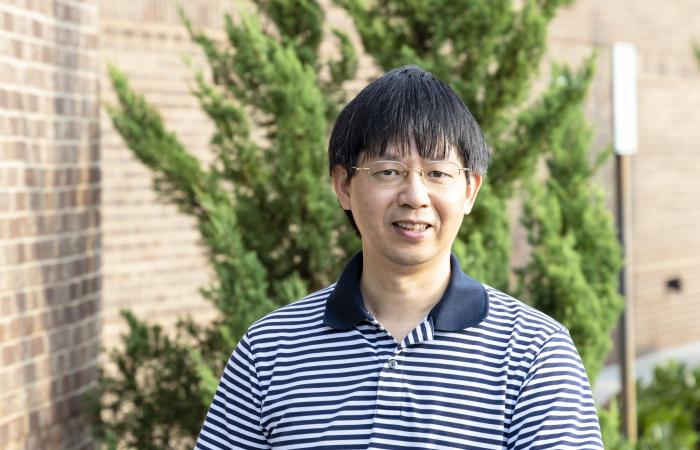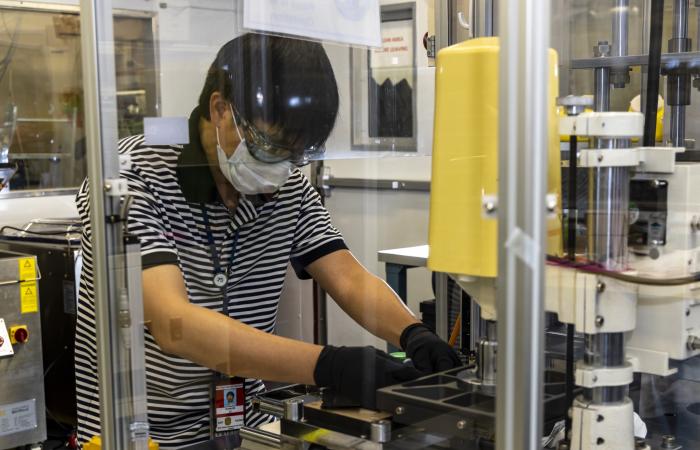-

Jianlin Li, leader of the Energy Storage and Conversion Manufacturing Group, directs the development of advanced manufacturing schemes and pilot-scale devices into emerging energy storage and conversion research. Credit: Carlos Jones/ORNL, U.S. Dept. of Energy
-

Jianlin Li, leader of the Energy Storage and Conversion Manufacturing Group, directs the development of advanced manufacturing schemes and pilot-scale devices into emerging energy storage and conversion research. Credit: Carlos Jones/ORNL, U.S. Dept. of Energy
-

Jianlin Li, leader of the Energy Storage and Conversion Manufacturing Group, directs the development of advanced manufacturing schemes and pilot-scale devices into emerging energy storage and conversion research. Credit: Carlos Jones/ORNL, U.S. Dept. of Energy
-

Jianlin Li, leader of the Energy Storage and Conversion Manufacturing Group, directs the development of advanced manufacturing schemes and pilot-scale devices into emerging energy storage and conversion research. Credit: Carlos Jones/ORNL, U.S. Dept. of Energy
In his career focused on energy storage science, Jianlin Li has learned that discovering new ways to process and assemble batteries is just as important as the development of new materials.
He found a place where he could do both at the Department of Energy's Battery Manufacturing Facility at Oak Ridge National Laboratory, where scientists explore the use of advanced materials all the way from the molecular level to manufacturing of pilot-scale pouch cells.
"Part of the uniqueness of the work I perform here is that we're not just discovering new materials, we're figuring out how these materials work together as battery components," Jianlin said. His work pursues the goal of improved materials and processes that result in batteries that can store more energy at a lower cost, while being safer and long-lasting.
"We have lots of equipment here that allows us to make things more relevant to industry," he said. "We work closely with industry at the BMF. With our equipment, we can take an experimental material and turn it into a small pouch cell that can be more easily scaled into a commercial battery."
Making an impact with his work is a main driver for Jianlin, who recently took on the role of leader for ORNL's Energy Storage and Conversion Manufacturing Group in the Electrification and Energy Infrastructures Division.
Technology that can increase consumer acceptance of electric vehicles and decarbonize transportation is a key goal at DOE. Batteries that can hold more energy and last through more charging cycles, while being cheaper and safer with improved electrical range, are very desirable, Jianlin noted. At the same time, those ultra-efficient batteries can be integrated with the grid at the megawatt scale to help power operators balance their loads and accommodate more renewable energy.
Jianlin had a fascination for energy systems growing up, and a knack for chemistry, math and physics. He decided to combine those fields and pursue materials science, earning his bachelor's and master's degrees from the University of Science and Technology of China. He then earned his doctorate in materials science and engineering from the University of Florida in 2009, where he concentrated on solid oxide fuel cells. He was the first in his family to earn a doctoral degree.
"I've always been very curious about how things work together, especially from a chemistry perspective," Jianlin said. "I felt materials science - figuring out those interfaces of materials - was a great way to really contribute to the energy field."
Jianlin landed at ORNL as a postdoctoral researcher fresh out of Florida and with an eagerness to make an impact. He switched to the study of battery systems rather than energy conversion, but science had a way of bringing him back to his beginnings. "Energy conversion and solid oxide fuel cells as I studied in school are very similar to our solid-state battery research now, so it's been a very smooth transition. We've had a lot of very good successes on our team."
Jianlin and his colleagues have developed cobalt-free battery cathodes, for instance, helping to resolve a critical materials supply chain challenge, as well as a new high-energy-density lithium battery design and a process to speed up production of those batteries. He is also tackling materials and processes to design a battery that can more easily accommodate extreme-fast charging - essential to charge an electric vehicle as quickly as a gas station fill-up.
The scientists are exploring ways to make battery recycling more efficient, cheaper and sustainable as well. Jianlin's work led to a method that replaces the use of organic solvents and their associated disposal issues with a water-based process for electrode recycling. Recovering critical materials from spent batteries addresses the battery waste issue while resolving the supply chain risk of purchasing new materials that are typically produced overseas.
"The work we do here at ORNL goes from materials discovery to synthesis and then translating all those materials and the technology to something that can be commercialized. I really take pride in that," Jianlin said. "I want to tell my daughter when we're out for a car ride, you know, your father helped invent that. That would make me very proud."






